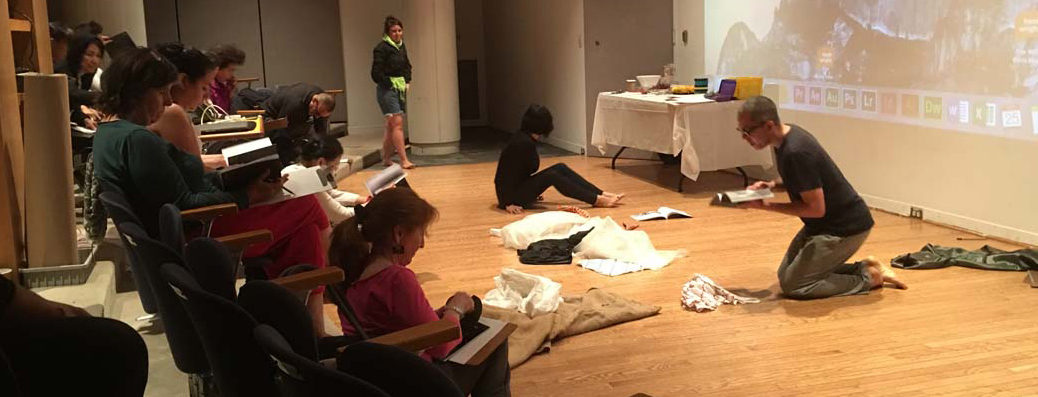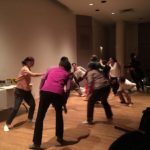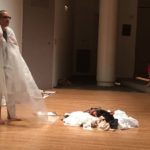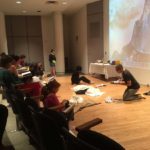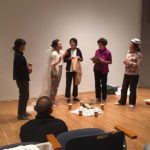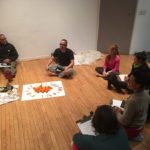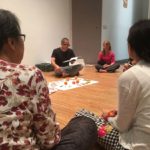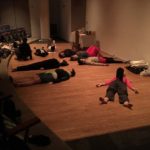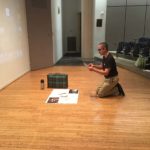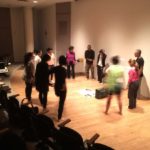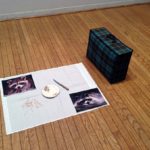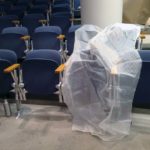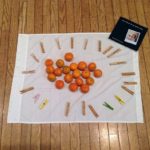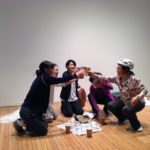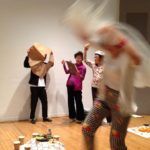Our Time Together Performing
I can mentally picture people gathering their belongings, checking their stoves carefully, making sure that they have their keys and their IDs with them, and putting cough drops and metro cards in their bags. Most New Yorkers leave their homes each day as if ready to embark on a long pilgrimage of some sort. Many of us travel though the city with a significant amount of belongings, from practical items that can save our lives to sentimental ones that are meant to nourish our hearts. On Sunday, September 25th, 2016, a group of fifteen people or so trekked from Queens, Manhattan, the Bronx, and Brooklyn to the Queens Museum to attend Our Time Together Performing, the improvisational workshop on performance and life that I was to lead at this organization.
Our Time Together Performing was inspired by the teachings on movement, performance art, art in everyday life, theater, activism, and self-care articulated by Anna Halprin, Augusto Boal, Linda Mary Montano, and Luke Dixon. I would also say with certainty that our workshop was infused with the spirit of progressive education that characterized the philosophy of radical thinker and founder of the City and Country School in Manhattan, Caroline Pratt. For years, I have been applying Pratt’s experiments on play and playing to my adult classes, as well as to my performative events. I could not think of a better opportunity to test Pratt’s ideas than with a group of grown ups in the theater of the Queens Museum. Our class could take on the roles of actors and enact life on stage for an invisible audience, or we could forget about the stage and turn the seating area into our playground.
“How to get here” marked the first exercise for our group. As participants entered the auditorium, I challenged them to fully inhabit the communal space that we were meant to build, performatively speaking. Yet “how to breath” was as much of a priority as getting here, and we hence practiced inhaling while expanding our diaphragms, and exhaling while caving them in. Breathing was then integrated into a warm-up that entailed moving different parts of our bodies, from eyes to ankles, using circular motions. The idea was to emulate the choreography of the universe and to relate the movement of planets to the movement of our bodies. Dormant muscles and cells were slowly awakened. Bodies were ready to dance. But the notion of dance implies rehearsed steps and virtuosity. The dance that I asked participants to perform had more to do with becoming aware of their bodies and the environment with which they were to interact. Skipping chairs, crawling like a toddler, or rolling on the polished wood of the stage were all possibilities. In her book Returning to Heath with Dance, Movement and Imagery, Anna Halprin tells us how “Movement is happening everywhere all the time. It is the motions of our cells, the pulse of our blood, the rhythm of our breath.” In our case, movement lead to voice, and participants took turns using guttural sounds to narrate deeply personal stories that they wrote prior to vocalizing them. Bodies were now relaxed enough to play!
Theater as spaceship. Theater as subterranean space. Theater as womb. Theater as elevator. Theater as cave. Theater as playground to build hideouts and to brew ideas for future performances and actions. But play is so much about the moment. A group of five women in our class proved this to be true. They emerged out of an improvised fort in the seats and transformed themselves on stage with what they had at hand. They then turned the materials for the class into props for a performance that included mooncakes and a white bicycle helmet. Performance like play was to unfold in the moment.
A placemat with various items positioned on the stage floor served as the class’ oracle. This welcoming arrangement initially consisted of a white cloth on which I placed two pictures of raccoons, several toothpicks, a vintage plate, and a knife. Towards the end of the workshop, these items were replaced by wooden and plastic clothepins, a bunch of tiny clementines, and a copy of the publication Life as Material for Art and Vice Versa. Rosalina Mestric smiled on the cover of the book. The placemat was eventually removed, the clementines were eaten, and the stage emptied for the closing of the workshop. My goal was for participants to return to their homes full of questions yet fully relaxed. We got together to do Savasana or the corpse pose, a Yoga posture that promotes deep relaxation. I used the two raccoon pictures to write thank you notes to Mariella and Guido at the Queens Museum. After Savasana, the group dispersed as discreetly as it congregated to rejoin outside the performance of life.
Our Time Together Performing was presented in collaboration with No Longer Empty. At the conclusion of the workshop participants were invited to submit a work to Nicolás’ open call for HERE IN JAMAICA, a digital exhibition to be featured on No Longer Empty’s website (http://www.nolongerempty.org/nc/home/what-we-do/artists/artist/dumit-estevez-raful-nicolas/).
Special thanks to Sara Guerrero-Rippberger, Guido Garaycochea, Mariella Suárez, Danny Corona, Susan Rippberger, Tiburcia, the Queens Museum and No Longer Empty.
Nicolás Dumit Estévez Raful,
Saturday, October 1, 2016, Bronx, New York
Text and images: © 2016 Nicolás Dumit Estévez Raful.
Nicolás Dumit Estévez Raful treads an elusive path that manifests itself performatively or through experiences where the quotidian and art overlap. Concurrently, this path has been informed by a strong personal interest in immigration, cultural hybridization and Estévez Raful’s understanding of identity as a process always in flux. He hence approaches the concepts of home and belonging to the U.S. American context from the perspective of a Lebanese-Dominican, Dominican York who was baptized as a Bronxite: a citizen of the Bronx. He has taught, exhibited and performed extensively in the U.S. as well as internationally. Estévez Raful has received mentorship in art in everyday life from Linda Mary Montano, a historic figure in the performance art field. Residencies attended include P.S. 1/MoMA, Yaddo and the MacDowell Colony. Estévez Raful Holds an MFA from Tyler School of Art, Temple University, Philadelphia, PA, where he studied with Coco Fusco; and an MA from Union Theological Seminary in the City of New York. Publications include Pleased to Meet You, Life as Material for Art and Vice Versa (editor) and For Art’s Sake. Born in Santiago de los Treinta Caballeros, Dominican Republic, Estévez Raful lives and works in the Bronx.

